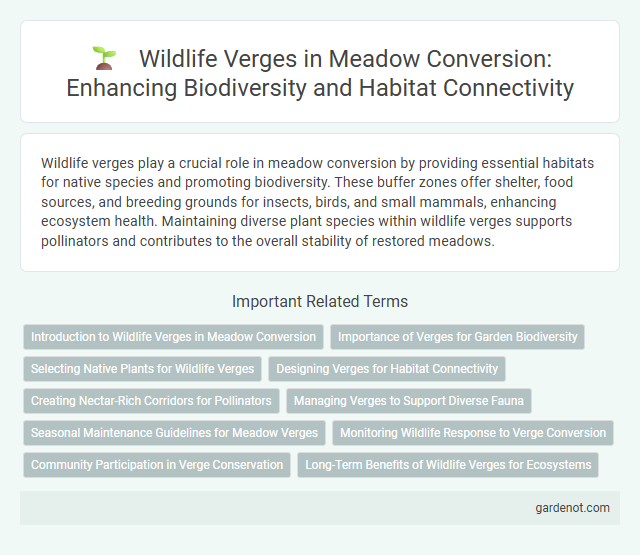Wildlife verges play a crucial role in meadow conversion by providing essential habitats for native species and promoting biodiversity. These buffer zones offer shelter, food sources, and breeding grounds for insects, birds, and small mammals, enhancing ecosystem health. Maintaining diverse plant species within wildlife verges supports pollinators and contributes to the overall stability of restored meadows.
Introduction to Wildlife Verges in Meadow Conversion
Wildlife verges are narrow strips of vegetation located along the edges of roads or fields, established during meadow conversion to enhance biodiversity and provide critical habitats for local fauna. These verges support a variety of flora and fauna, including pollinators, small mammals, and bird species, contributing to ecological connectivity within agricultural landscapes. Implementing wildlife verges in meadow conversion plans improves habitat quality, promotes species diversity, and aids in conservation efforts across rural environments.
Importance of Verges for Garden Biodiversity
Wildlife verges play a crucial role in supporting garden biodiversity by providing essential habitats for pollinators, insects, and small mammals. These strips of unmowed or native vegetation act as natural corridors that enhance species diversity and promote ecological balance. Maintaining verges with native wildflowers and grasses increases food sources and shelter, fostering a resilient and thriving garden ecosystem.
Selecting Native Plants for Wildlife Verges
Selecting native plants for wildlife verges ensures compatibility with local ecosystems, providing essential habitat and food sources for pollinators, birds, and small mammals. Native species such as wildflowers, grasses, and shrubs support biodiversity by maintaining soil health and promoting natural pest control. Prioritizing plants adapted to regional climate and soil conditions enhances verge resilience and ecological value.
Designing Verges for Habitat Connectivity
Designing wildlife verges for habitat connectivity involves creating continuous green corridors that support the movement of species between fragmented habitats. These verges should include native wildflowers, grasses, and shrubs to provide food resources and shelter for pollinators, small mammals, and birds. Strategic placement alongside roads and agricultural fields enhances ecological networks and promotes biodiversity resilience in meadow conversion projects.
Creating Nectar-Rich Corridors for Pollinators
Creating nectar-rich corridors within wildlife verges significantly enhances foraging habitats for pollinators like bees, butterflies, and hoverflies. Diverse native wildflowers such as clover, knapweed, and wild marjoram provide continuous bloom periods supporting pollinator health and biodiversity. Strategic planting along roadsides and field edges connects fragmented habitats, promoting pollinator movement and ecosystem resilience.
Managing Verges to Support Diverse Fauna
Managing wildlife verges through regular cutting cycles and native wildflower planting creates vital habitats that support diverse fauna, including pollinators, small mammals, and birds. Maintaining structural diversity with varied sward heights and minimizing pesticide use enhances invertebrate populations, crucial for local ecosystem health. Incorporating native grasses and wildflower species improves forage availability and shelter, promoting biodiversity on converted meadow verges.
Seasonal Maintenance Guidelines for Meadow Verges
Seasonal maintenance of wildlife verges in meadow conversion involves strategic mowing and removal of cuttings to promote biodiversity and native flora growth. During late summer, mowing should be minimized to allow wildflowers to set seed, while autumn management focuses on removing biomass to prevent nutrient build-up that favors aggressive species. Spring maintenance includes reducing soil disturbance to protect emerging wildlife habitats and encouraging natural regeneration of meadow plants.
Monitoring Wildlife Response to Verge Conversion
Monitoring wildlife response to verge conversion involves systematic surveys that track changes in species diversity and abundance over time. Utilizing remote cameras, acoustic sensors, and regular field observations helps quantify the effectiveness of meadow restoration on local fauna. Data collected provides insight into habitat utilization, guiding adaptive management strategies to enhance biodiversity along converted road verges.
Community Participation in Verge Conservation
Community participation in wildlife verge conservation enhances biodiversity by involving local residents in planting native flora and monitoring habitats. Engaging volunteers in regular maintenance, such as removing invasive species and litter, supports ecosystem health and promotes environmental stewardship. Collaborative efforts between councils and communities foster sustainable verge management, ensuring the preservation of native wildlife corridors across urban landscapes.
Long-Term Benefits of Wildlife Verges for Ecosystems
Wildlife verges provide critical habitats that support biodiversity by offering food, shelter, and breeding grounds for numerous species, enhancing ecosystem resilience over time. These natural strips act as ecological corridors, facilitating species movement and genetic exchange, which are essential for sustaining healthy wildlife populations. Long-term benefits include improved soil health, increased pollination, and natural pest control, contributing to overall ecosystem stability and productivity.
Wildlife verge Infographic

 gardenot.com
gardenot.com